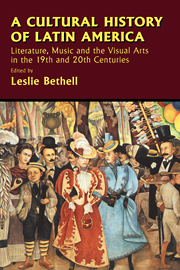 A Cultural History of Latin America
A Cultural History of Latin America 5 - Poetry since 1950
Published online by Cambridge University Press: 05 June 2012
Summary
INTRODUCTION
By the 1950s Latin American poets were writing within the context of their own continental traditions. From Rubén Darío's break with the postcolonial Hispanic tradition in the 1890s, to the following generational break embodied in Vicente Huidobro's avant-garde poems in the 1920s and César Vallejo's experimental Trilce (1922), the desire to be as modern as possible by absorbing the latest modes from Europe continued to dominate Latin American poetry. A typical avant-garde poem from the 1920s refused to conform to metre as a definition of what was poetic (i.e. free verse), and sought a new kind of subjective sensibility through playing with syntax, punctuation, common sense, and obvious metaphorical associations, in order to express the novelty and originality of the ‘romance’ of technology ushered in by the cosmopolitan twentieth century. This typical avant-garde poem serves, at a formal level, as a mould that includes the Brazilian modernistas as much as the Mexican estridentistas. One of the most representative collections of this period was Carlos Oquendo de Amat's 5 metros de poemas (1927). A third wave of Latin American poets who wanted to ‘make it new’ were less Europeanized. Here the emblematic collection was Pablo Neruda's Residencia en la tierra I y II (1935), whose title was a proclamation of an earthy or materialistic position. Neruda idiosyncratically created a new generational style exploring telluric, or sensual, relations with the empirical world that did not apparently feed off culture. In 1930 Carlos Drummond de Andrade claimed that stupidity made poets sigh for Europe where in fact only making money counted.
- Type
- Chapter
- Information
- A Cultural History of Latin AmericaLiterature, Music and the Visual Arts in the 19th and 20th Centuries, pp. 261 - 290Publisher: Cambridge University PressPrint publication year: 1998
- 1
- Cited by
